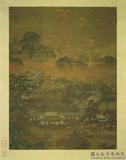清董邦達南屏晚鐘 軸
推薦分享
資源連結
連結到原始資料 (您即將開啟新視窗離開本站)後設資料
- 資料識別:
- 故畫002614N000000000
- 資料類型:
- 類型:繪畫
- 型式:靜態圖像
- 著作者:
- 董邦達
- 主題與關鍵字:
- 名勝 城牆 籬笆、圍牆 橋 寺廟 房舍 楊柳 竹 寒林.枯樹 松 江河、湖海
- 出版者:
- 數位化執行單位:國立故宮博物院
- 格式:
- 本幅 127.3x64.3公分、全幅 67公分
- 關聯:
- 石渠寶笈續編(圓明園),第七冊,頁3918&*故宮書畫錄(卷八),第四冊,頁108&*故宮書畫圖錄,第十二冊,頁49-50&* 董邦達(西元一六九九至一七六九年),字孚存,號東山,浙江富陽人。雍正癸丑(一七三三)進士,仕至禮部尚書。畫山水從董其昌入手,得元人筆墨精神。 南屏山當西湖之南,層巒聳列,翠嶺橫披,宛若屏障,下有淨慈寺,寺鐘一鳴,山谷皆應,逾時方息。 &* Tung Pang-ta (1699-1769) style name Fu-ts’un, sobriquet Tung-shan was a native of Fu-yang, Chekiang Province. He received the chin-shih degree in 1733 and afterward entered the court of the Ch’ien-lung Emperor. He assisted in the compilation of the imperial catalogue Shih-ch’u pao-chi and later served as minister of the Board of Rites. He started his landscape paintings with Tung Ch’i-chang of the Ming dynasty as his model. He captured the brushwork and elegance of Yüan painting giving his style clarity and beauty. On the southern shore of the West Lake are mountain ranges and ravines. Mount Nanp’ing is a celebrated place and nearby is a temple called Ching-tz’u Temple. When the temple bell is tolled, its sounds reverberate through the mountains and ravines.
- 管理權:
- 國立故宮博物院
授權聯絡窗口
- 國立故宮博物院圖像授權、出版授權、影音資料授權-申請流程說明
http://www.npm.gov.tw/zh-TW/Article.aspx?sNo=03003061






